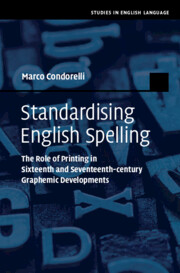 Standardising English Spelling
Standardising English Spelling from Part III - Case Studies
Published online by Cambridge University Press: 31 March 2022
Chapter 7 deals with the redistributions of ˂u˃/˂v˃ and ˂i˃/˂j˃ in word-initial position. The main empirical finding is a sudden shift from an earlier graphotactic distribution to a phonographic one, which occurred between the 1620s and 1640s. From the quantitative and qualitative results collected for the positional spellings, a compelling linguistic scenario becomes apparent behind the positional redistribution. By taking an eclectic, large-scale perspective on spelling standardisation, one can overcome some of the variables that inevitably correlate, and likely underlie, any abrupt spelling changes in small, specific collections, for example the latent influence of different exemplars between different editions of an individual text. Departing from a more precise understanding of the chronology and the lexical diffusion of the positional spellings, this case study uncovers, for the first time, some of the mechanisms involved in the uses of different positional spelling conventions between the sixteenth and the seventeenth centuries. In particular, the chapter argues for a close connection between the abrupt, one-generational changes in the uses of word-initial ˂u˃/˂v˃ and ˂i˃/˂j˃, and compositional factors that affected the Early Modern English printing industry.
To save this book to your Kindle, first ensure no-reply@cambridge.org is added to your Approved Personal Document E-mail List under your Personal Document Settings on the Manage Your Content and Devices page of your Amazon account. Then enter the ‘name’ part of your Kindle email address below. Find out more about saving to your Kindle.
Note you can select to save to either the @free.kindle.com or @kindle.com variations. ‘@free.kindle.com’ emails are free but can only be saved to your device when it is connected to wi-fi. ‘@kindle.com’ emails can be delivered even when you are not connected to wi-fi, but note that service fees apply.
Find out more about the Kindle Personal Document Service.
To save content items to your account, please confirm that you agree to abide by our usage policies. If this is the first time you use this feature, you will be asked to authorise Cambridge Core to connect with your account. Find out more about saving content to Dropbox.
To save content items to your account, please confirm that you agree to abide by our usage policies. If this is the first time you use this feature, you will be asked to authorise Cambridge Core to connect with your account. Find out more about saving content to Google Drive.